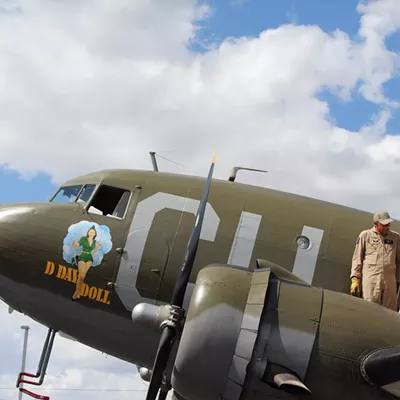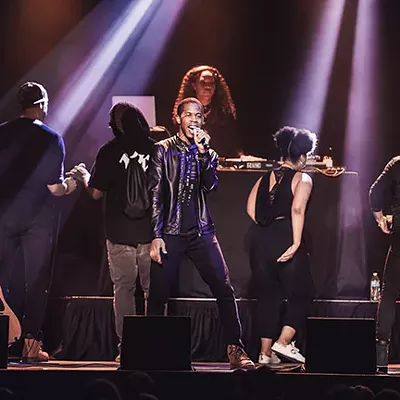They are fierce images that have survived the havoc and span of a brutal history. When the Nazis stormed into power in Germany in 1933, their early targets weren't just the Jews.
This weekend launches the Tucson opening of the United States Holocaust Memorial Museum's touring exhibition, Nazi Persecution of Homosexuals 1933-1945. The show opened in November 2002, and its display at Tucson's Jewish Community Center marks a first on several fronts, says Dr. Ted Phillips, the show's curator at the Washington, D.C. museum.
"The general public is our target audience for the show," Phillips says. "When we brought it to Phoenix last year, it was in a downtown public library. In Tucson, the JCC inaugurates our foray into a more Jewish-centered space."
But an array of organizations are helping bring the show to a wider audience. Collaboration has been key to the breadth of its numerous city-wide, related events.
"It's been an amazing process," says Susan Silverman, JCC's interfaith and cultural arts coordinator. "It sets a tremendous example for how communities can work together."
The Jewish Community Relations Council started the ball rolling, says Silverman.
"They instigated the Wingspan/JCC connection. Wingspan staff wanted to host the exhibit at their space, but it was too small. So they came to us, and it was a perfect fit."
Wingspan--Tucson's center for lesbian, gay, bisexual and transgender communities--has had minimal connection with the JCC, save for sponsoring a LGBT night at the annual Jewish film festival. With this exhibit, their relationship has bloomed, as they each helped coach the more than 30 organizations--queer, multi-faith, intergenerational, arts, educational--to birth the varied events taking place during the exhibit's three-week stint.
"It's been great working with Wingspan," says Silverman. "It helps us realize that we have a lot in common. We both serve minority populations. It'll bring people to the JCC who aren't necessarily accustomed to coming here."
Phillips concurs. "The involvement has been amazing. We got an outpouring of interest, despite some orthodox Jews saying this show was thematically inappropriate."
Phillips says the exhibit asks one question over and over: What is the notion of prejudice?
"I think it can deal with any group," he says, "Jewish or homosexual."
This issue of ownership of victimization has challenged both exhibit and event organizers.
Says Silverman, "We're anticipating this notion of it's my holocaust from the (typically heterosexual and Jewish) survivor population. It poses some challenges for us. The JCC is family-oriented. We have 250 kids coming through here every day. How do you present the issue of the Holocaust, but also talk about sexuality?"
Herself the parent of two teens, Silverman adds, "If you're going to look at the history of the Holocaust, you have to realize that the Nazis came first for the disabled, then the gay people, then the Jews."
Phillips explains that few gay survivors ever come forward. "As attics are cleared out by relatives, we're losing any vestige of their existence."
Go back 70 years, and the picture historians like Phillips paint of Berlin before the goose-stepping Nazis marched in is one featuring a large gay community.
"It was an amazing city," says Phillips, "undergoing changes in social, political and cultural arenas. There were an estimated 400,000 gay people living in Berlin."
The Nazis snuffed out all so-called "decadence." German courts ruled that any contact between men deemed to have sexual intent, even simple looking or touching, could be grounds for arrest and conviction. Most gathering places for gay men and lesbians closed, fundamentally disrupting their public lives.
A couple of generations have now slipped by. Despite this, Phillips says the images in the exhibit draw in contemporary eyes.
"Many of the pictures are police mug shots. So, we're looking directly at their faces and into their eyes. It's very intimate. I don't think the years distance us much. As a gay man myself, I had to step away while I wore my historian's hat. The regime identified these people as outcasts. That's possible in any tyrannical government.
"One of my favorite images is one of the few that isn't a police photo, but is of a man and his male partner sitting on a bench, out in public. In the background, out of focus, is a woman, who we assume is this guy's wife--a marriage of convenience. This shadowiness parallels so much of what went on during that time," adds Phillips.
He also explains why there's a dearth of images of lesbians in the exhibit.
"Paragraph 175 (the German criminal code) only targeted men. It took more filtering to find out if a woman was lesbian or just 'asocial,' the label given to many women who subverted the expression of femininity--being a mother or a wife. These women were lumped in with prostitutes or those who refused to take jobs. So you have to read things more closely than you do with evidence of violation of Paragraph 175."
Gay men were the real threat to undermining Nazi values, he adds. But once the Nazis were removed from power, gay men still had to contend with the law.
"The German criminal code wasn't removed from the books in West Berlin until 1969. There was still a lot of hiding by gay people," says Phillips.
Even in the United States, religion and culture still hold sway over many criminal codes. Explains Susan Silverman about her own family's experiences, "My 50-year-old cousin waited to come out until after his orthodox rabbi father died."
With that kind of orthodoxy in mind, Silverman says a number of the exhibit's events address issues of Judaism's response to gay lifestyles.
"Most of Tucson's rabbis have been great, particularly reform rabbis who've always been very open to the LGBT community. But more conservative rabbis won't acknowledge it in their congregations. We were far more interested in expanding dialogue among all the denominations. So we're having a chaplain training that incorporates leaders of many different faiths."
In the end, what can history teach us? Phillips has an idea.
"I'm ever hopeful, he says, "that we can learn from that famous George Santayana quote: 'Those who cannot remember the past are condemned to repeat it.' There really are profound lessons if people will just listen."










